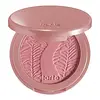What's inside
What's inside
 Key Ingredients
Key Ingredients

 Benefits
Benefits

No benefits
 Concerns
Concerns

 Ingredients Side-by-side
Ingredients Side-by-side

Mica
Cosmetic ColorantPentaerythrityl Tetraisostearate
EmollientHydrogenated Vegetable Oil
EmollientOctyldodecyl Stearoyl Stearate
EmollientAluminum Hydroxide
EmollientAluminum Starch Octenylsuccinate
AbsorbentSilica
AbrasiveHydrogenated Polyisobutene
EmollientCaprylyl Glycol
EmollientEthylhexylglycerin
Skin ConditioningCaprylic/Capric Triglyceride
MaskingKaolin
AbrasiveLauroyl Lysine
Skin ConditioningEthylene/Propylene/Styrene Copolymer
Pentaerythrityl Tetra-Di-T-Butyl Hydroxyhydrocinnamate
AntioxidantSorbitan Tristearate
EmulsifyingButylene/Ethylene/Styrene Copolymer
Tocopherol
AntioxidantCI 77891
Cosmetic ColorantCI 45410
Cosmetic ColorantCI 77007
Cosmetic ColorantCI 15850
Cosmetic ColorantMica, Pentaerythrityl Tetraisostearate, Hydrogenated Vegetable Oil, Octyldodecyl Stearoyl Stearate, Aluminum Hydroxide, Aluminum Starch Octenylsuccinate, Silica, Hydrogenated Polyisobutene, Caprylyl Glycol, Ethylhexylglycerin, Caprylic/Capric Triglyceride, Kaolin, Lauroyl Lysine, Ethylene/Propylene/Styrene Copolymer, Pentaerythrityl Tetra-Di-T-Butyl Hydroxyhydrocinnamate, Sorbitan Tristearate, Butylene/Ethylene/Styrene Copolymer, Tocopherol, CI 77891, CI 45410, CI 77007, CI 15850
Talc
AbrasiveCetearyl Isononanoate
EmollientZinc Stearate
Cosmetic ColorantCetyl Acetate
EmollientStearoxy Dimethicone
EmollientIsopropyl Lanolate
EmollientSilica
AbrasivePropylparaben
PreservativeTriclosan
PreservativeMethylparaben
PreservativeAcetylated Lanolin Alcohol
EmollientBHA
AntioxidantMica
Cosmetic ColorantCI 77891
Cosmetic ColorantCI 77491
Cosmetic ColorantCI 77492
Cosmetic ColorantCI 77499
Cosmetic ColorantCI 77742
Cosmetic ColorantCI 45410
Cosmetic ColorantCI 73360
Cosmetic ColorantCI 17200
Cosmetic ColorantCI 15880
Cosmetic ColorantIngredients Explained
These ingredients are found in both products.
Ingredients higher up in an ingredient list are typically present in a larger amount.
CI 45410 is a synthetic red-pigment and dye.
It often goes by both Red 28 or Red 27; manufacturers label both ingredients as CI 45410.
This dye is commonly found in makeup because it imparts a vivid color. Some types of this dye change color based on pH level and interaction with moisture:
Your skin has a natural pH of around 4.5 - 5.5.
According to the FDA, CI 45410 is not permitted for use in eye products.
Red 27 is a flourescein dye and commonly used as a fluorescent tracer in medicine.
Learn more about CI 45410Ci 77891 is a white pigment from Titanium dioxide. It is naturally found in minerals such as rutile and ilmenite.
It's main function is to add a white color to cosmetics. It can also be mixed with other colors to create different shades.
Ci 77891 is commonly found in sunscreens due to its ability to block UV rays.
Learn more about CI 77891Mica is a naturally occurring mineral used to add shimmer and color in cosmetics. It can also help improve the texture of a product or give it an opaque, white/silver color.
Serecite is the name for very fine but ragged grains of mica.
This ingredient is often coated with metal oxides like titanium dioxide. Trace amounts of heavy metals may be found in mica, but these metals are not harmful in our personal products.
Mica has been used since prehistoric times throughout the world. Ancient Egyptian, Indian, Greek, Roman, Aztec, and Chinese civilizations have used mica.
Learn more about MicaSilica, also known as silicon dioxide, is a naturally occurring mineral. It is used as a fine, spherical, and porous powder in cosmetics.
Though it has exfoliant properties, the function of silica varies depending on the product.
The unique structure of silica enhances the spreadability and adds smoothness, making it a great texture enhancer.
It is also used as an active carrier, emulsifier, and mattifier due to its ability to absorb excess oil.
In some products, tiny microneedles called spicules are made from silica or hydrolyzed sponge. When you rub them in, they lightly polish away dead skin layers and enhance the penetration of active ingredients.
Learn more about Silica